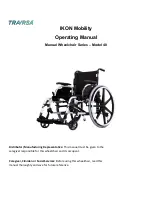
5 USE
Inc. All rights reserved
69
Figure 38-C: Tango AC belt
5.9. ANCHOR POINTS FOR SPECIALIZED TRANSIT
5.9.1. INSTRUCTIONS FOR SPECIALIZED TRANSIT
•
The 4-wheel and 6-wheel Tango AC complies with BNQ 6645-001 (2020) and
ISO 7176-19 standards. These models were subjected to frontal impact testing
when used as a forward-facing seat in a motor vehicle.
•
The dynamic tests were performed in a forward-facing direction, using a dummy
restrained by lap and shoulder belts (e.g., a shoulder belt as part of a three-point
belt restraint system).
Do not alter or modify the wheelchair's mounting points or
structural and frame parts/components without permission
from Orthofab.
•
Place the wheelchair facing the front of the vehicle in the tie-down area; activate
the wheel locks (brakes) and turn off the power if necessary.
•
Attach tie-down straps to the vehicle floor anchors as specified by the anchoring
system manufacturer.
•
Attach the four tie-down hooks at the following locations:
The 4-wheel and 6-wheel Tango wheelchairs are equipped with 4 anchor points (see
Figures 39-A and 39-B).
On the Tango AC, the torque required to hold the
belt in place without breaking the wheelchair is 80
lb-in.
Tightening should be done with a 7/16" torque
wrench.
Place the belt in the femoral position (
A
) or in the
pelvic position (
B
) (see Figure 38-C).
A
B









































![Dietz Rehab AS[01] User Manual preview](http://thumbs.mh-extra.com/thumbs/dietz-rehab/as-01/as-01_user-manual_2495939-01.webp)






